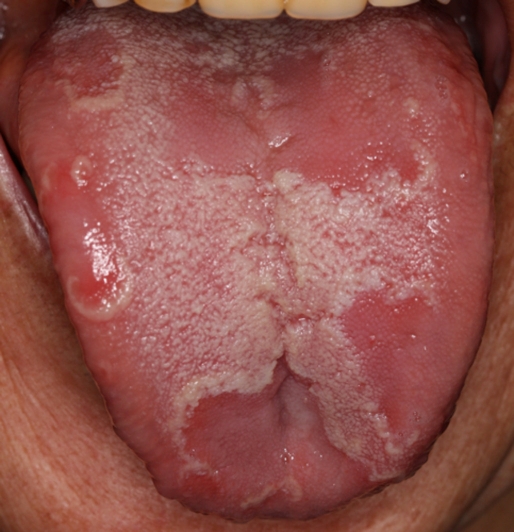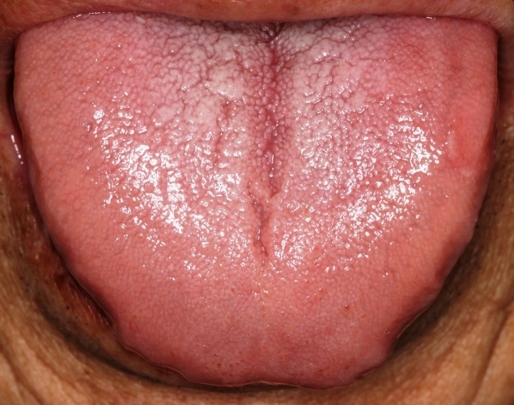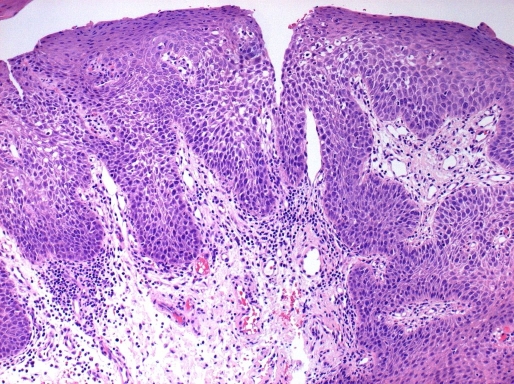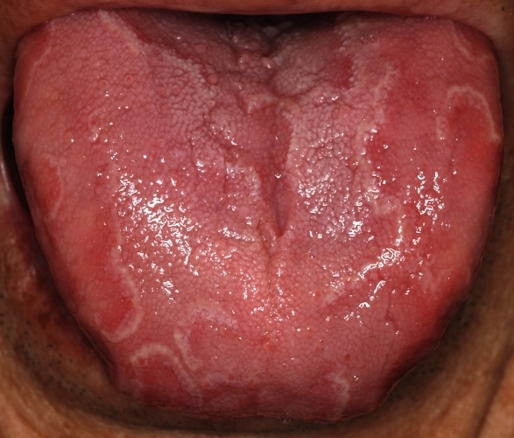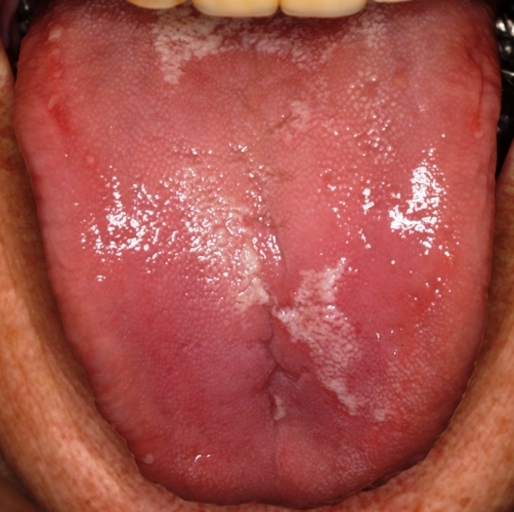Abstract
Background
Geographic tongue, or benign migratory glossitis, is usually an asymptomatic inflammatory disorder of the tongue mucosa of unknown etiology. It is characterized by circinate, erythematous, ulcer-like lesions of the dorsum and lateral border of the tongue due to loss of filiform papillae of the tongue epithelium. Symptomatic treatments have not been evaluated rigorously.
Main observation
We describe herein two cases of adult patients with persistent and painful geographic tongue successfully treated with topical application of 0.1% tacrolimus ointment.
Conclusion
To our knowledge, this is the first report of successful treatment with topical 0.1% tacrolimus for symptomatic geographic tongue. Clinical trials are needed to confirm the efficacy and the safety of topical tacrolimus in treating geographic tongue.
Keywords: benign migratory glossitis, calcineurin inhibitors, geographic tongue, tacrolimus, treatment
Introduction
Geographic tongue, or benign migratory glossitis, is usually an asymptomatic inflammatory disorder of the tongue mucosa of unknown etiology. It is characterized by circinate, erythematous, ulcer-like lesions of the dorsum and lateral border of the tongue due to loss of filiform papillae of the tongue epithelium. Lesions tend to change location, pattern, and size within minutes to hours. There have been many reports regarding the association between geographic tongue and psoriasis.[1,2] We describe herein two cases of adult patients with persistent and painful geographic tongue successfully treated with topical application of 0.1% tacrolimus ointment.
Case Report
CASE 1
A 77-year-old Japanese man was referred with a 5-year history of painful geographic tongue unresponsive to various medications, such as vitamin B12, itraconazole and nonsteroidal anti-inflammatory drugs (NSAIDs). He presented with irregular erythematous patches and whitish elevated borders on the dorsum of the tongue. After using 0.1 % tacrolimmus ointment twice daily for two weeks his symptom were significantly improved [Fig. 1A–B] without any side effects.
Figure 1A.
Geographic tongue in patient 1 before therapy.
Figure 1B.
Geographic tongue in patient 1 after therapy.
CASE 2
A 77-year-old Japanese woman was referred with a 5-year history of painful geographic tongue unresponsive to vitamin B12, itraconazole, NSAIDs and topical dexamethasone. Her clinical symptoms were irregular erythematous patches and whitish elevated borders on the dorsum of the tongue. A biopsy specimen obtained from her tongue showed psoriform epidermal hypertrophy with neutrophilic infiltration in the epidermis [Fig. 2]. The lesions and her discomfort were significantly improved with 0.1% tacrolimus ointment twice daily for two weeks [Fig. 3A–B].
Figure 2.
A biopsy specimen obtained from the tongue of patient 2 shows psoriform epidermal hypertrophy with neutrophilic infiltration in the epidermis.
Figure 3A.
Geographic tongue in patient 2 before therapy.
Figure 3B.
Geographic tongue in patient 2 after therapy.
Discussion
Geographic tongue is a mucous inflammatory disease of unknown etiology. The typical clinical findings are wellcircumscribed red depapiliated areas of the dorsal aspect of the tongue delineated by an elevated whitish-yellow annulus. The histopathological findings are parakeratosis and psoriasiform hyperplasia with neutrophilic infiltration into the epithelium.[1] There have been many reports regarding the association between geographic tongue and psoriasis.[2–4] Since geographic tongue is usually asymptomatic and only rarely does significant pain develop and persist,[5,6] patients do not usually require any treatment. Symptomatic treatments have not been evaluated rigorously. The use of systemic cyclosporine has been reported in the treatment of geographic tongue.[7] Our patients complainedthat the lesional pain was strong. We tried various therapies including topical corticosteroid ointment for their painful condition but those treatments were not effective. Considering the histological similarity between geographic tongue and psoriasis, we introduced topical tacrolimus ointment. Within two weeks, their troublesome condition was improved without any side effects and no exacerbation was found after the follow-up period of 2 months.
Tacrolimus is an immunosuppressive macrolide and its anti-inflammatory action is similar to that of cyclosporine, which involves the inhibition of interleukin 2 (IL-2) production by T cells.[8] As well as pimecrolimus, topical formulations of tacrolimus have beenestablished for the treatment of atopic dermatitis. Recently, topical tacrolimus has been shown to be effective in the treatment of other dermatoses such as erythematodes[9], vitiligo[10], seborrheic dermatitis[11], rosacea[12], oral lichen planus[13] and psoriasis. In 2009 The American Academy of Dermatology guidelines for psoriasis therapy with topical tacrolimus were recommended for facial and intertriginous psoriasis.[14] Because of its high molecular weight (822.03), tacrolimus hardly penetrates through the stratum corneum when it is applied to normal skin. Since the permeability of the barrier becomes greater in the mucosa and/or in the lesional skin of inflammatory skin disorders, tacrolimus easily penetrates the barrier and exerts immunosuppressive actions after topical use. Sometimes, topical tacrolimus causes stinging at the application site, but our two patients did not complain about stinging after its topical use.
The results of therapies on two patients are difficult to interpret because of the possibility that the observed response may merely reflect the natural course of the disease rather than the effect of the medication. However, in our case, we believe that a real therapeutic effect took place because the persistent lesions have not recurred with topical tacrolimus. Further clinical trials are warranted to confirm the efficacy and the safety of topical tacrolimus for geographic tongue.
Acknowledgments
We appreciate the pertinent advice given by Katsuko Kikuchi, MD, PhD, a lecturer of Tohoku University School of Medicine.
References
- Assimakopoulos D, Patrikakos G, Fotika C, Elisaf M. Benign migratory glossitis or geographic tongue: an enigmatic oral lesion. Am J Med. 2002;113:751–755. doi: 10.1016/s0002-9343(02)01379-7. [DOI] [PubMed] [Google Scholar]
- Zunt SL, Tomich CE. Erythema migrans - a psoriasiform lesion of the oral mucosa. J Dermatol Surg Oncol. 1989;15:1067–1070. doi: 10.1111/j.1524-4725.1989.tb03124.x. [DOI] [PubMed] [Google Scholar]
- Sklavounou A, Laskaris G. Oral psoriasis: report of a case and review of the literature. Dermatologica. 1990;180:157–159. doi: 10.1159/000248018. [DOI] [PubMed] [Google Scholar]
- Femiano F. Geographic tongue (migrant glossitis) and psoriasis. Minerva Stomatol. 2001;50:213–217. [PubMed] [Google Scholar]
- Menni S, Boccardi D, Crosti C. Painful geographic tongue (benign migratory glossitis) in a child. J Eur Acad Dermatol Venereol. 2004;18:737–738. doi: 10.1111/j.1468-3083.2004.01032.x. [DOI] [PubMed] [Google Scholar]
- Drage LA, Rogers RS 3rd. Clinical assessment and outcome in 70 patients with complaints of burning or sore mouth symptoms. Mayo Clin Proc. 1999;74:223–228. doi: 10.4065/74.3.223. [DOI] [PubMed] [Google Scholar]
- Abe M, Sogabe Y, Syuto T, Ishibuchi H, Yokoyama Y, Ishikawa O. Successful treatment with cyclosporin administration for persistent benign migratory glossitis. J Dermatol. 2007;34:340–343. doi: 10.1111/j.1346-8138.2007.00284.x. [DOI] [PubMed] [Google Scholar]
- Kelly PA, Burckart GJ, Venkataramanan R. Tacrolimus: a new immunosuppressive agent. Am J Health Syst Pharm. 1995;52:1521–1535. doi: 10.1093/ajhp/52.14.1521. [DOI] [PubMed] [Google Scholar]
- Drüke A, Gambichler T, Altmeyer P, Freitag M, Kreuter A. 0.1% Tacrolimus ointment in a patient with subacute cutaneous lupus erythematosus. J Dermatolog Treat. 2004;15:63–64. doi: 10.1080/09546630310017852. [DOI] [PubMed] [Google Scholar]
- Lepe V, Moncada B, Castanedo-Cazares JP, Torres-Alvarez MB, Ortiz CA, Torres-Rubalcava AB. A double-blind randomized trial of 0.1% tacrolimus vs 0.05% clobetasol for the treatment of childhood vitiligo. Arch Dermatol. 2003;139:581–585. doi: 10.1001/archderm.139.5.581. [DOI] [PubMed] [Google Scholar]
- Braza TJ, DiCarlo JB, Soon SL, McCall CO. Tacrolimus 0.1% ointment for seborrhoeic dermatitis: an open-label pilot study. Br J Dermatol. 2003;148:1242–1244. doi: 10.1046/j.1365-2133.2003.05383.x. [DOI] [PubMed] [Google Scholar]
- Bamford JT, Elliott BA, Haller IV. Tacrolimus effect on rosacea. J Am Acad Dermatol. 2004;50:107–108. doi: 10.1016/s0190-9622(03)02157-1. [DOI] [PubMed] [Google Scholar]
- Vente C, Reich K, Rupprecht R, Neumann C. Erosive mucosal lichen planus: response to topical treatment with tacrolimus. Br J Dermatol. 1999;140:338–342. doi: 10.1046/j.1365-2133.1999.02672.x. [DOI] [PubMed] [Google Scholar]
- Menter A, Korman NJ, Elmets CA, Feldman SR, Gelfand JM, Gordon KB, Gottlieb A, Koo JY, Lebwohl M, Lim HW, Van Voorhees AS, Beutner KR, Bhushan R. Guidelines of care for the management of psoriasis and psoriatic arthritis. Section 3. Guidelines of care for the management and treatment of psoriasis with topical therapies. J Am Acad Dermatol. 2009;60:643–659. doi: 10.1016/j.jaad.2008.12.032. [DOI] [PubMed] [Google Scholar]



